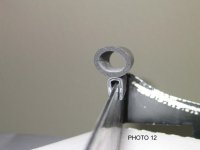Hey Louis. I think 'bowsher pretty much covered it, but what I think was going on back in the day that they were trying to fix, was localized hot spots from steam pockets on modified (over-bored) 351's. Like he said, this may not have "fixed" the actual issue, but I think it did help some of the higher performance types (this was a common race fix back in the day, and promoted often in the magazines) by most likely getting the steam pockets to dissipate more quickly by flowing directly out of the most effected rear cylinders.
That said, you don't seem to qualify for any of the issues addressed by that. General hotter running from low-speed under load conditions, with a bone stock engine. And a newer engine to boot, which supposedly are not as prone to the old casting shift issues of the older blocks.
Not having been bored over, yours is unlikely to have localized hot spots unless yours was simply a defective block. Which could happen of course, but it's low on the list. I would check a few other things first.
First of all, describe what you feel is "hot" in your case? What temperature is it running, and is your gauge reading correctly? Your '86 engine's proper operating range is 195° to 205° if I'm not mistaken. What is yours reading?
If it's indeed reading hot, then you first need to confirm your gauge's readings. If you haven't already that is.
Next, what is "correct timing" as you've specified, and is your engine still running all of it's original smog equipment or is it sitting in a Bronco with all of it's stuff removed?
Or is this by any chance actually still in the '86 truck?
No matter, I would try bumping the timing up a couple of degrees at a time until it either starts pinging or stops running nicely. If the timing is retarded for what your particular engine likes, you might just find that advancing the timing cures, or at least reduces the temperature readings.
Stock C4, but what is your differential gear ratio? If you're pushing 33 to 35 inch tires or more, with 3.50 gears, then you're overburdening your engine's cooling system from both inside (high load) and outside (more heat from the transmission) and not helping matters.
And finally, what temperatures are you reading? Yes, it's nice to be able to do what it takes to keep it below the 205 degree range, but in reality even in the 220 to 230 range you're not overheating. As long as it doesn't try to creep up above that, you're still in the relatively safe zone. Granted, your headroom is greatly reduced and you could more easily run into trouble if you have a heat spike and are not watching the gauge, but you'll still have the relative feel of how the engine is working, so not likely to get caught off guard except under duress.
In a pinch, you could add an electric fan in a pusher arrangement in front of the radiator, but this has been a hit-or-miss proposition with Broncos for years. Not much room for much of a fan, and not necessarily a lack of airflow issue anyway. But it can help under certain conditions.
I would still try to bump up the timing, then lower the idle back down as you go up in timing, to keep things normal. See what it gets you.
If it doesn't reduce temps, at the very least you might find the engine is happier and runs better with a little extra timing. And it might just help with the temps too.
I guess the first thing to try though, is to confirm your gauge readings with an external IR thermometer, or at the very least a good basting thermometer (or whatever the proper kitchen term is) in the filler neck.
As a last resort, you might try the coolant cross-over modification. You wouldn't be the first to do it, and won't likely be the last. Others here have done it I believe, with mixed results. Maybe some of them will see this discussion and chime in.
Like Broncobowher said though, it's not likely going to hurt anything or make it worse. I just don't think it's called for in your case.
Good luck.
Paul














